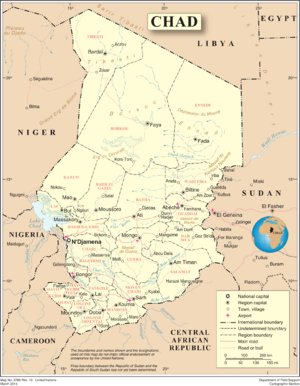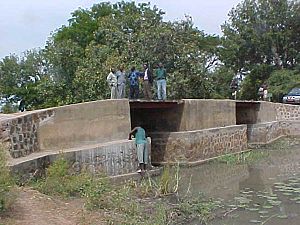List of rivers of Chad facts for kids
Chad is a large country in Central Africa, and like many places, its rivers are super important! They provide water for people, animals, and plants, and they help shape the land. Rivers are like the veins of the Earth, carrying water from higher places down to lakes or oceans. In Chad, rivers flow into different areas, which we call "drainage basins." Think of a drainage basin as a giant bowl where all the rain and river water collects and flows towards one main exit point.
Contents
Rivers of Chad: Waterways and Basins
The rivers in Chad are organized into different groups based on where their water eventually ends up. Some rivers flow into huge lakes within Chad, while others connect to much larger river systems that eventually reach the ocean. Understanding these river systems helps us see how water connects different parts of the country and even other countries.
Rivers Flowing to the Gulf of Guinea
Even though Chad is far from the ocean, some of its rivers are part of a massive system that reaches the Atlantic Ocean! This happens through the Niger River, which is one of Africa's longest rivers.
- The Mayo Kébbi river is a key river in southwestern Chad. It flows out of Chad and eventually joins the Benue River in Nigeria. The Benue River then flows into the mighty Niger River, which finally empties into the Gulf of Guinea on the Atlantic coast. It's amazing how water can travel such long distances!
The Lifeline of Lake Chad
Lake Chad is a very important lake in Central Africa, and many rivers in Chad flow into it. This lake is like a giant oasis in the semi-desert region, providing water for millions of people and animals across several countries. The rivers that feed Lake Chad are its lifeblood.
- The Chari River is the most important river that flows into Lake Chad. It provides about 90% of the lake's water! The Chari River starts in the Central African Republic and flows northwest through Chad. It's a long river, stretching about 1,400 kilometers (870 miles).
- The Logone River is the main tributary of the Chari River. This means it's a big river that flows into the Chari. The Logone River forms part of the border between Chad and Cameroon.
- The Pendé River is a tributary of the Logone River.
- The Mbéré River also flows into the Logone River.
- The Bahr Erguig is another river that flows into the Chari.
- The Bahr Salamat is a river that joins the Chari from the east.
- The Bahr Azoum is a tributary of the Bahr Salamat.
- The Ouadi Kadja flows into the Bahr Azoum.
- The Bahr Azoum is a tributary of the Bahr Salamat.
- The Ouham River is a significant tributary that feeds the Chari River.
- The Nana Barya is a river that flows into the Ouham.
- The Bahr Kéita is another river that contributes water to the Chari system.
- The Ko River is a smaller river that flows into the Chari.
- The Bragoto River is a tributary of the Ko River.
- The Bahr Aouk (also called Aoukalé) is another river that flows into the Chari.
- The Logone River is the main tributary of the Chari River. This means it's a big river that flows into the Chari. The Logone River forms part of the border between Chad and Cameroon.
- The Bahr el Ghazal is a very interesting waterway. It's actually a "wadi," which means it's a riverbed that is often dry but can fill with water during the rainy season. It flows from Lake Chad northwards, but it doesn't always have water.
Rivers of Lake Fitri
Lake Fitri is another important lake in Chad, though it's much smaller than Lake Chad. It's an endorheic lake, meaning it doesn't have an outlet to the sea; its water mostly evaporates.
- The Batha River is the main river that feeds Lake Fitri. Like many rivers in arid regions, the Batha River can be seasonal, meaning it flows strongly during the rainy season but might dry up at other times of the year.
Rivers of Darfur
Some rivers in eastern Chad are part of a system that flows towards the Darfur region of Sudan. These rivers are often "wadis," which are riverbeds that only carry water during heavy rains.
- The Wadi Howar is an ancient riverbed that once flowed from Chad all the way to the Nile River in Sudan. Today, it's mostly a dry wadi, but it shows how interconnected the water systems of Africa once were, especially during wetter periods in history.




